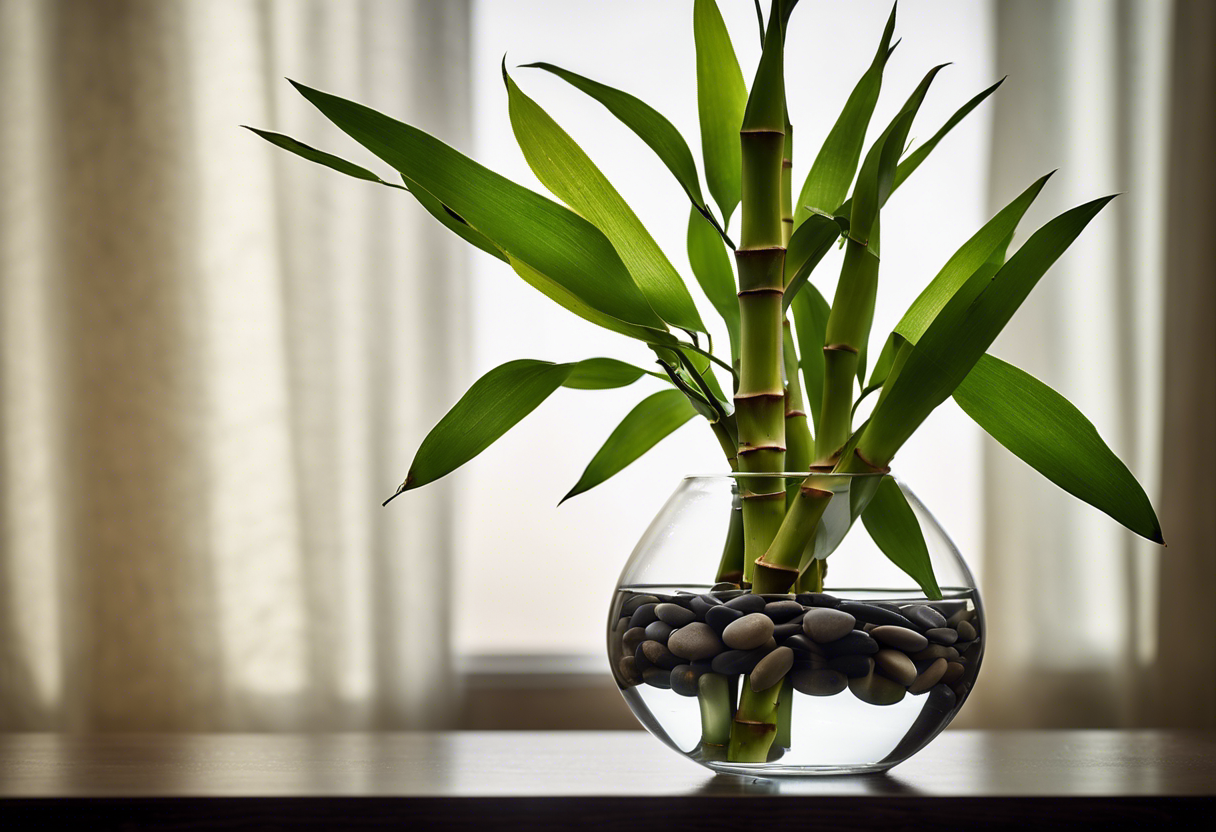Ever found yourself staring at your lucky bamboo plant, wondering why it’s looking more like a sad twig than the vibrant green symbol of good fortune it’s supposed to be? Well, you’re not alone. I’ve been there too, and let me tell you, reviving a dying lucky bamboo plant can feel like rocket science. But fear not! With this handy guide on How to Revive a Dying Lucky Bamboo Plant, we’ll turn that brown thumb of yours into a green one yet.
So grab your watering can and put on your gardening gloves. It’s time to breathe some life back into that wilting stalk. So don’t click away! Keep reading about How to Revive a Dying Lucky Bamboo Plant.
Key Takeaways
- Identify signs of a dying lucky bamboo plant such as yellow leaves or stalks, and weak roots.
- Overwatering, lack of light, and temperature extremes can cause the plant to die.
- To revive it, trim off the yellow parts and move the plant to a well-lit area but away from direct sunlight.
- Change water every two weeks and ensure the temperature is between 65°F – 90°F.
- If roots are rotten, propagate new plants from healthy parts.
Understanding Lucky Bamboo
The Lucky Bamboo plant, a symbol of good fortune, has its roots deep in the Asian culture. Its popularity has spread worldwide due to its resilience and aesthetic appeal. But hey, even the toughest need some TLC, right? We’ll dive into that later.
What is a Lucky Bamboo Plant?
So what’s this Lucky Bamboo we’re talking about? Well, it’s not actually bamboo at all! It’s officially known as Dracaena sanderiana. A bit of a tongue twister, huh? This plant is famous for its long, slender stalks and vibrant green leaves.
It’s also quite the chameleon! It can adapt to various environments, making it one helluva houseplant. But remember folks, even though it’s hardy, it still needs proper care to thrive.
The Importance of Proper Care for Lucky Bamboo
Now let’s get serious for a moment. Proper care for Lucky Bamboo is crucial if you want your green buddy to stick around. Just like us humans, plants can get sick too if they’re neglected.
Neglecting your Lucky Bamboo could lead to yellowing leaves or worse – death! And nobody wants that on their conscience. So buckle up folks, because we’re about to embark on a journey on how to revive a dying Lucky Bamboo plant.
Identifying Signs of a Dying Lucky Bamboo
Hey, plant parents! If your lucky bamboo is looking a bit under the weather, don’t panic. Here’s how to revive a dying lucky bamboo plant by spotting the signs early. You know, like Sherlock Holmes but for lucky bamboo care.
Yellowing Leaves
Ever noticed your lucky bamboo sporting yellow leaves? That’s not its attempt at autumn fashion. It’s one of the symptoms of unhealthy bamboo.
Yellow leaves can be caused by too much sunlight or over-fertilization. Don’t worry though, it’s not all doom and gloom. To treat this, move your plant to a shadier spot and ease up on the fertilizer. Remember, less is more when it comes to treating yellow leaves in lucky bamboo.
Browning Stalks
Now let’s talk about browning stalks – another red flag in the world of dying lucky bamboo signs. This usually means your plant is getting too much water or poor quality water.
The solution? Try using filtered or distilled water instead of tap water. And remember, moderation is key! Overwatering can lead to brown stalks in lucky bamboo, so keep it balanced!
Root Rot
Last but definitely not least – root rot. This bad boy is a serious issue for any plant parent trying to figure out how to keep their green babies healthy.
If you notice soft, mushy roots or a foul smell coming from the pot, you’re dealing with root rot in lucky bamboos. The best way to treat this? Remove the rotten parts and repot your plant in fresh soil.
Remember folks, knowing how to identify these issues is half the battle in learning how to revive a dying lucky bamboo plant!
Causes of a Dying Lucky Bamboo
Hey there, plant lovers! Ever wondered why your lucky bamboo is looking a bit under the weather? Dying lucky bamboo causes can range from overwatering to poor quality water. Let’s dive in!
Overwatering or Underwatering
So, you’ve been showering your bamboo with love… and water. But guess what? Too much of anything isn’t good. Overwatering symptoms in lucky bamboo include yellow leaves and root rot. On the flip side, an underwatered lucky bamboo might have wrinkled leaves.
Now, don’t panic! To fix an overwatered bamboo plant, reduce watering frequency and ensure proper drainage. For those underwatered ones, increase watering gradually until it perks up.
Inadequate Light Conditions
Next up – light conditions. Your lucky bamboo ain’t no vampire! It needs light but not direct sunlight. Low light can lead to weak growth and loss of color.
The trick here is balance. The ideal light conditions for lucky bamboo are bright but indirect sunlight. So maybe move it away from that window just a smidge?
Incorrect Temperature and Humidity Levels
Temperature check! These plants prefer warmer temperatures between 65-95°F (18-35°C). Anything below could send your plant into a chilly shock!
Humidity levels matter too! The best humidity level for indoor bamboos is around 50%. Too dry or too humid can cause leaf tips to turn brown.
Poor Quality Water
Last but not least, let’s talk about H2O quality. Hard water or water with high chlorine content can harm your plant.
The best water for lucky bamboo? Rainwater or filtered water works great! If not available, tap water left standing overnight will do.
Remember folks, understanding these issues is key on how to revive a dying lucky bamboo plant. Happy planting!
Reviving Techniques for a Dying Lucky Bamboo
So, you’re looking to revive your dying lucky bamboo? Don’t fret! With a few tweaks here and there, your plant will be back in the green in no time.
Adjusting Watering Practices
First things first, let’s talk about watering. Both overwatering and underwatering can cause harm to your bamboo plant. Overwatering can lead to root rot, while underwatering can leave your plant parched and wilted.
To avoid this, you need to find the optimal watering schedule for bamboos. A good rule of thumb is to water when the top inch of soil feels dry. But remember, every plant is unique so keep an eye on yours and adjust as needed.
Modifying Light Exposure
Next up is light exposure. Too much sunlight can scorch your lucky bamboo, while too little light may stunt its growth. It’s all about finding that sweet spot!
The ideal light conditions for lucky bamboo are bright but indirect light. So maybe place it near a window with sheer curtains or in a well-lit room away from direct sunlight.
Regulating Temperature and Humidity
Temperature and humidity also play a big role in your bamboo’s health. These plants prefer warmer temperatures and high humidity levels.
To maintain optimal temperature for lucky bamboo growth, try keeping your indoor climate around 65-95°F (18-35°C). And don’t forget about humidity! If you live in a dry area, consider using a humidifier or placing the pot on a tray filled with pebbles and water.
Changing the Water Source
Finally, let’s talk about water quality. If you’ve been using tap water for your lucky bamboo, it might be time for a change.
Tap water often contains chlorine which isn’t great for plants. Switching to filtered or distilled water for bamboos can make a big difference in your plant’s health. So give it a try, and watch your lucky bamboo thrive!
Preventive Measures to Keep Your Lucky Bamboo Healthy
Hey there, plant parents! Let’s talk about the importance of preventive measures in maintaining a healthy bamboo. It’s all about regular monitoring, proper feeding and fertilizing, and ensuring adequate drainage. These steps are crucial for your indoor bamboo plant care routine.
Regular Monitoring and Maintenance
First things first, let’s discuss regular plant monitoring. It’s like taking your pet for a check-up. You gotta keep an eye on your lucky bamboo. Look out for any changes in color or growth patterns. This is the key to maintaining lucky bamboo.
Next up, maintenance! Just like you need a haircut every now and then, so does your lucky bamboo. Prune it regularly to promote healthy growth. Remember folks, an ounce of prevention is worth a pound of cure when it comes to your bamboo plant check-up routine.
Proper Feeding and Fertilizing
Moving on to feeding and fertilizing – these are the meals for your plants! Providing proper nutrition is essential for their well-being. Think of it as cooking a balanced meal for your green buddies.
Now, what should you feed them? Well, organic fertilizer works wonders for bamboos! They love it just as much as we love grandma’s homemade cookies! So remember folks, feeding lucky bamboo with the right stuff can make all the difference!
Ensuring Adequate Drainage
Last but not least – drainage! Imagine standing in waterlogged shoes all day…yuck! That’s how your lucky bamboo feels with poor drainage.
Adequate drainage prevents root rot and other nasty diseases from invading your beloved bamboo. So ensure that water doesn’t pool at the bottom of the pot. This is one of those golden rules in preventing root rot in bamboos.
So there you have it folks – the ABCs of how to revive a dying lucky bamboo plant. Keep these tips in mind and your lucky bamboo will be as healthy and happy as a clam at high tide!
To Wrap Up
Well, folks, it’s been a rollercoaster ride through the bamboo jungle. We’ve learned the ins and outs of How to Revive a Dying Lucky Bamboo Plant, making us feel like botanical superheroes ready to save the day!
So next time your lucky bamboo looks as sad as a wet weekend, remember these tips! Let’s turn that brown thumb green and keep our leafy friends thriving.





